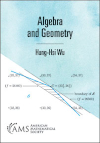- About MAA
- Membership
- MAA Publications
- Periodicals
- Blogs
- MAA Book Series
- MAA Press (an imprint of the AMS)
- MAA Notes
- MAA Reviews
- Mathematical Communication
- Information for Libraries
- Author Resources
- Advertise with MAA
- Meetings
- Competitions
- Programs
- Communities
- MAA Sections
- SIGMAA
- MAA Connect
- Students
- MAA Awards
- Awards Booklets
- Writing Awards
- Teaching Awards
- Service Awards
- Research Awards
- Lecture Awards
- Putnam Competition Individual and Team Winners
- D. E. Shaw Group AMC 8 Awards & Certificates
- Maryam Mirzakhani AMC 10 A Awards & Certificates
- Two Sigma AMC 10 B Awards & Certificates
- Jane Street AMC 12 A Awards & Certificates
- Akamai AMC 12 B Awards & Certificates
- High School Teachers
- News
You are here
Algebra and Geometry

Buy Now:
Publisher:
AMS
Publication Date:
2020
Number of Pages:
375
Format:
Paperback
Price:
50.00
ISBN:
978-1-4704-5676-4
Category:
Textbook
[Reviewed by , on ]
Erika David Parr
07/11/2022
See our reviews of the other two volumes in this series, Precalculus, Calculus, and Beyond, and Rational Numbers to Linear Equations.
Algebra and Geometry is the second of three volumes by Hung-Hsi Wu rigorously exploring secondary mathematical content. The aim of this text, as the author explains, is to provide a coherent, clear, complete, and rigorous treatment of content from school mathematics, in contrast to the often fragmented, imprecise texts used for grade-level courses in high schools. The text is written as a textbook for high school mathematics teachers and mathematics educators, including those who may be instructors of courses for pre-service teachers, with the goal that high school teachers pass on their mathematical learning from this text to their students.
The textbook consists of sections coherently building on topics in algebra and geometry. In each section, formal definitions of central mathematical objects are provided (e.g.., function, altitude) along with examples, theorems, and their proofs, as well as some commentary on the purpose of these objects or theorems. At the end of each section are several exercises related to the key mathematical objects of the section and their characteristics. These exercises include many proof exercises (e.g., 1.1. 5 Given two bijective functions, prove that their composition is also bijective, 6.2.3a Show that the three altitudes of an equilateral triangle are equal (in length)). At times, pedagogical comments are also provided to contextualize the material of the section for a school classroom, or in response to potential student questions.
Chapters 1-5 cover material from high school algebra, from the concept of function and various functions such as quadratic, polynomial, exponential and logarithmic, through the fundamental theorem of algebra. Chapters 6-8 cover high school geometry content. Notably, the book diverges significantly from traditional school mathematics in that it builds from foundational isometries rather than a set of axioms (though it includes assumptions). The end of the text contains an appendix listing assumptions, definitions, theorems and lemmas used from volume 1 of this series, Rational Numbers to Linear Equations (Wu, 2020a). There is also a glossary of symbols used throughout, a bibliography, and functional index.
Given its tone and style, as well as the level of the exercises, I will add that it appears this text is designed for those with training in upper-level mathematics, and prior experience with proofs at the undergraduate level is assumed.
Erika David Parr is an assistant professor of mathematics at Rhodes College in Memphis, TN where she teaches courses in mathematics and statistics. She holds an M.A. in Mathematics and Ph.D. in Mathematics Education from Arizona State University.
See the publisher's website.
- Log in to post comments




